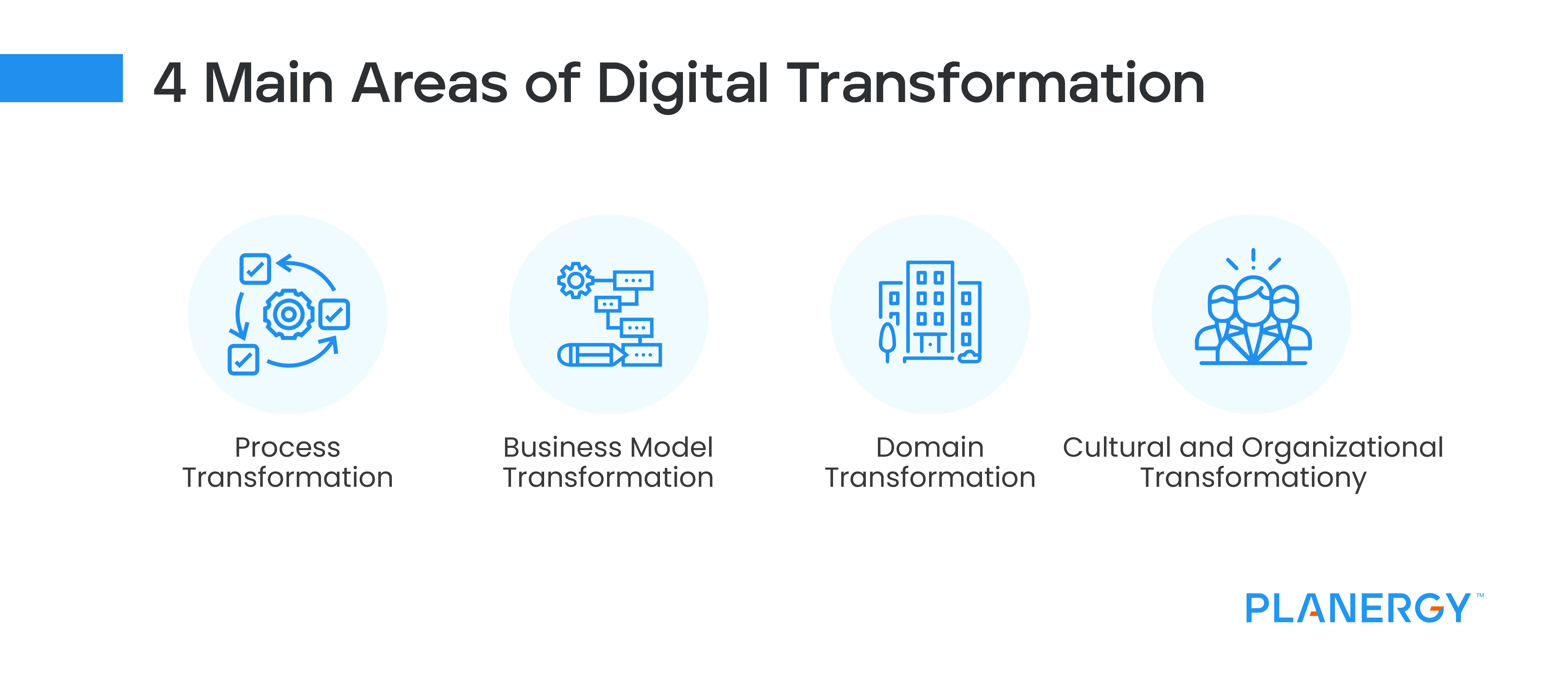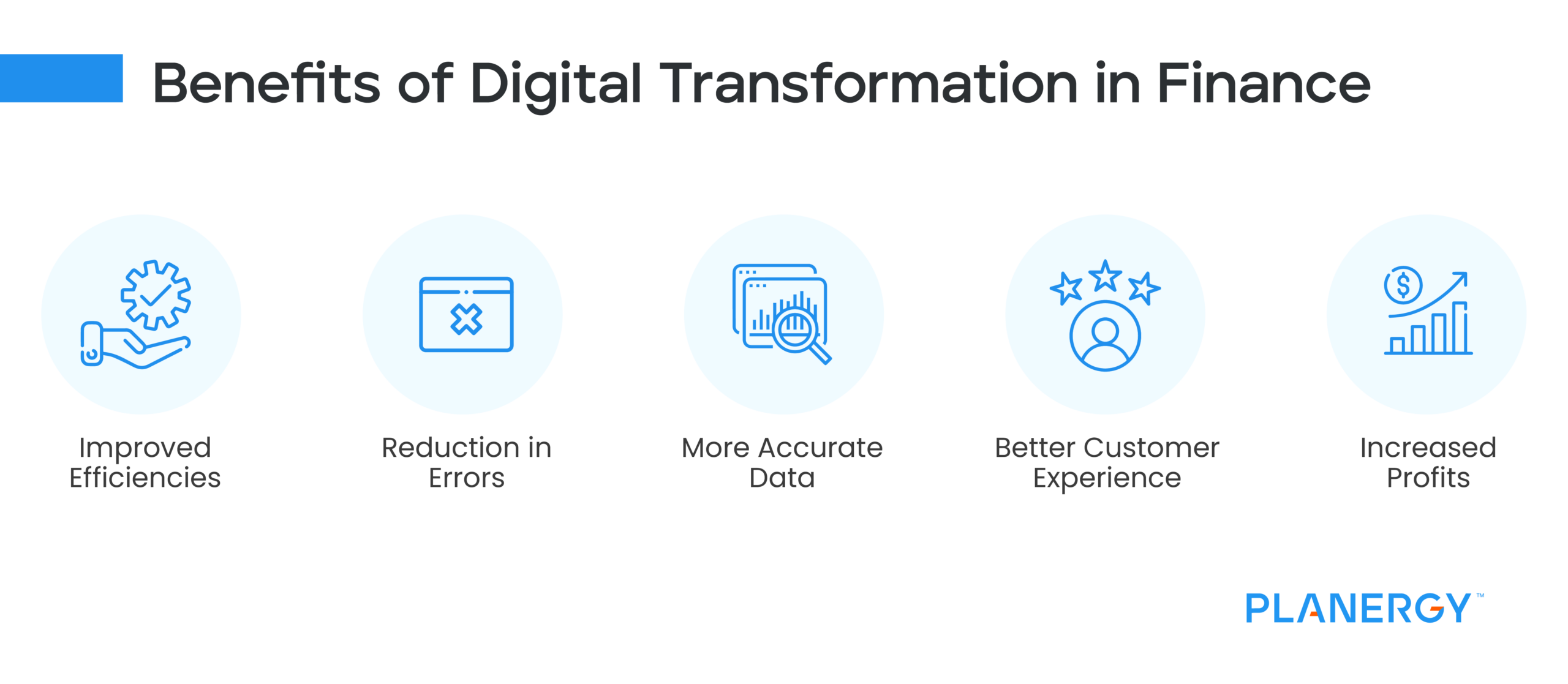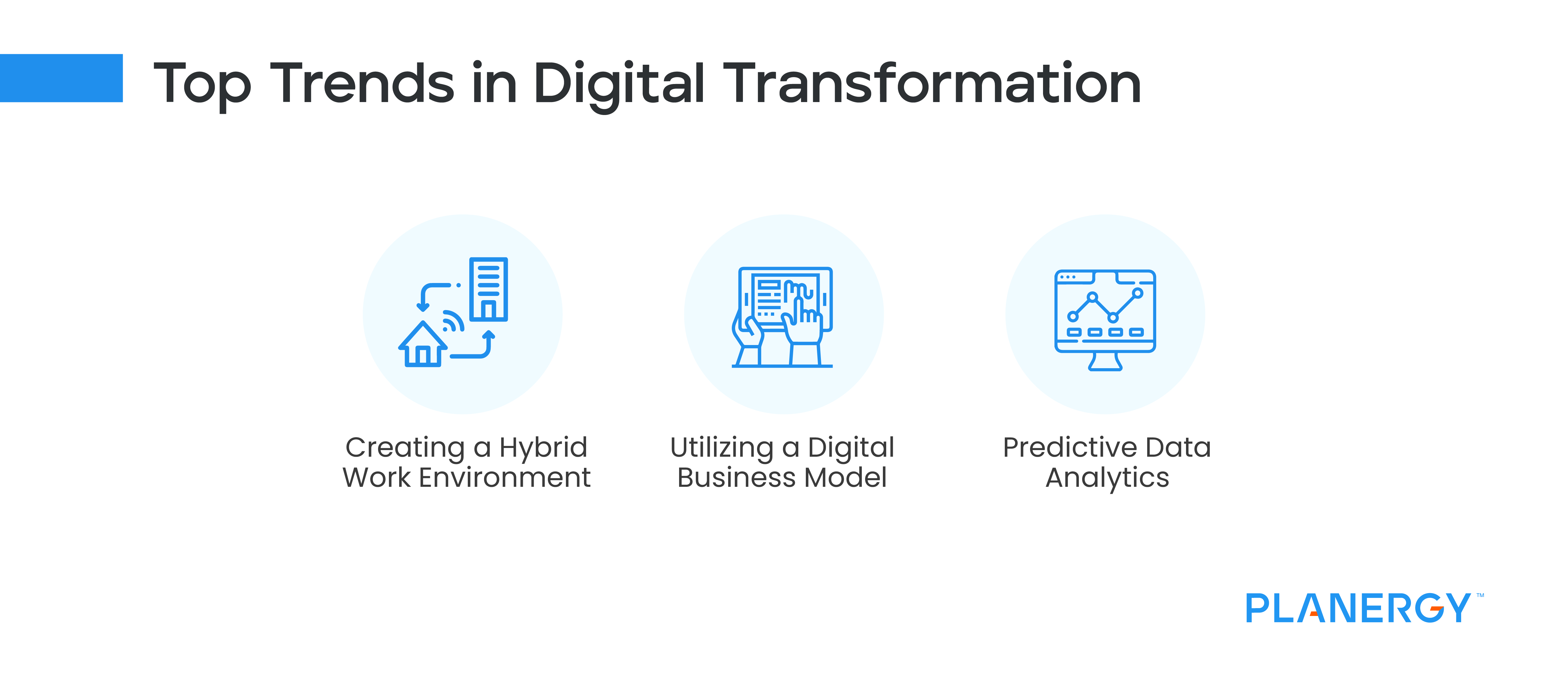As more businesses look to make the transition to digital transformation, CFOs know that the biggest impact will be seen in accounting and finance departments, with even small startups experiencing the benefits of going digital.
Though this transition began long before Covid-19 impacted businesses, the pandemic only served to accelerate the digital transformation process considerably.
But before we talk about the impact that digital transformation can have on financial services, let’s take a look at what digital transformation is.
What Does Digital Transformation Mean?
True digital transformation will look different for each company, with smaller business needs much different from those of a global enterprise organization.
But in all cases, digital transformation simply means the introduction and integration of digital technology into a business.
This transformation uses digital technology to create new business processes or modify existing processes.
For example, many customer-service-driven businesses such as banks have implemented digital transformation to improve customer experience, while reducing or eliminating repetitive tasks in the workplace.
If you’ve ever used a banking app or called your bank with a question or concern, you’ve been exposed to the benefits of digital transformation such as voice recognition and online check deposit.
Digital transformation in finance can be particularly fruitful, as many tasks associated with accounting and finance departments are highly repetitive.
Using digital transformation, many of those repetitive tasks can be automated, reducing the amount of paperwork that needs to be processed as well as the amount of time necessary to complete a task.
What Are the Four Main Areas of Digital Transformation?
There are four main areas involved in the digital transformation process.
To completely embrace digital transformation, it’s important that businesses address all four of these types rather than focusing on one or two areas.
-
Process Transformation
The first area that most businesses employ is process transformation. Technology like robotic process automation help to streamline traditional back-office processes in finance and accounting, while helping organizations begin to integrate technology company-wide.
Manufacturing companies are also implementing process transformation in the manufacturing process, implementing machine learning for a more streamlined manufacturing process.
-
Business Model Transformation
Business model transformation looks at the business as a whole and makes changes accordingly. Every business operates on a business model, and transforming that model requires a long look at the existing model and how value is determined in the industry.
Changing the fundamental ways in which a business operates is never easy, but sometimes it’s necessary. Ignoring industry change can put businesses in the red and quickly put them out of business altogether.
For example, while Blockbuster was unable to change its business model to stay in business, organizations like Netflix, which began as a video rental business quickly adapted to industry trends that customers preferred to access videos on other devices and ultimately created a business model that better suited their customer base.
-
Domain Transformation
Unlike business model transformation, domain transformation focuses on current business offerings, seeking to extend their current offerings to better suit their customer base.
For example, a retailer selling women’s clothing may use domain transformation to launch a rental service, so customers have the option to purchase an item or simply rent it.
Another example is a company that sells heavy equipment that now offers an online option for its customers to manage their equipment, allowing them to track information such as purchase date, pricing, required maintenance scheduling, usage hours, and repair details.
-
Cultural and Organizational Transformation
It’s impossible to complete this new framework without transforming your business as well. As we all know, introducing new technology can cause a tremendous amount of pushback from employees and other stakeholders.
When making the change to digital transformation, your employees must be included in the process, from the initial plan to the transformation itself. Many people fear the unknown and are reluctant to leave their comfort zone.
Don’t expect the culture to change overnight since cultural and organizational transformation remains a long-term work in progress. Instead, open up the lines of communication with employees throughout the process while providing a clear vision of expectations across the company.

For business owners just beginning the digital transformation journey, the process can feel overwhelming. But the first step should be to move your computing platform to the cloud.
What Are the Benefits of Digital Transformation in Finance?
Digital transformation brings with it a host of benefits, particularly for finance, which has traditionally struggled with inefficiencies and errors.
These are just a few of the benefits your finance department may see:
-
Improved Efficiencies
Touchless transactions and the use of blockchain will automate much of the manual processes that create logjams in a business. As a bonus, moving to a fully automated system will allow staff to concentrate on what’s important, and not on the piles of paper on their desk.
For example, banks and call centers have been utilizing increasingly sophisticated digital technology in recent years. This technology includes voice recognition, mobile check deposit, and the use of bots to help navigate customers to the correct location.
-
A Reduction in Errors
As we all know, there’s more than one way to make a mistake. There are four types of errors; rule-based errors, skill-based errors, knowledge-based errors, and simple mistakes.
A rule-based error is made when a wrong rule is applied to a process; a skill-based error is when skilled personnel makes the wrong decision during a process; a knowledge-based error is frequently committed by new employees who don’t have sufficient knowledge to complete a task, while simple mistakes are just that – a number keyed wrong, a document saved in the wrong area, or the wrong gauge used in machinery.
Whatever the cause of the mistake, digital transformation can significantly reduce or eliminate the most common errors.
-
More Accurate Data
Using data from standard reports has always been a necessity for businesses, with financial data used to make key management decisions. But standard reporting has its limitations, reporting historical data, not real-time data.
Using digital transformation, Finance professionals and CFOs can now merge standard reporting data with more unstructured data to create a better financial forecast in real-time.
For example, when you run your monthly financial statements, they provide a window into past company performance but offer no real insight into the future.
Another area where more accurate data can impact a company is customer data. Today, most retail businesses use some form of data collection when interacting with their customers.
But the real challenge is what to do with the data collected. Without the proper analysis, customer data is just taking up space on your computer.
Using digital transformation, your business can evolve beyond simple tracking of customer buying habits and let you drill down to the details, providing an unprecedented opportunity to customize communication with each customer individually, rather than placing them in groups, as is currently the common practice.
Another thing that digital transformation does is allow you to better protect your customer’s data by implementing better privacy and security measures when collecting data from your customers.
-
A Better Customer Experience
Speaking of customers, using digital transformation not only streamlines the entire customer interaction process but also provides your customers with a more intuitive experience.
Digital transformation also allows businesses to offer customer conveniences such as user portals, easy online payment options, and a more personalized sales experience.
This, along with standard industry expectations such as easy ordering, fast shipping, and increased product choices can help businesses find and retain customers for the long haul while increasing revenue.
-
Increased Profits
It’s no secret that businesses that introduce digital transformation have seen revenue growth. According to the SAP Center for Business Insights and Oxford Economics, businesses that have adopted digital transformation have experienced the following:
- 80% of the organizations that have completed digital transformation have seen an increase in profits.
- 85% of businesses report an increase in market share.
- Business leaders currently estimate a higher revenue growth than their closest competitors.
Increased profits are largely due to some of the additional benefits of adopting digital transformation including the ability to reduce product costs, more easily introduce new products, and development of additional revenue streams.

Where Should You Focus?
For business owners just beginning the digital transformation journey, the process can feel overwhelming. But the first step should be to move your computing platform to the cloud.
Using multiple desktop solutions in your business will slow any progress you may make on the digital transformation front, so before you begin the process, be sure to move your platforms to the cloud.
If you’re already operating on the cloud, it might be time to do a company assessment to identify an area that needs addressing immediately.
This could be streamlining workflow, greater job efficiency, or even creating a better customer experience.
Whatever area you identify, work on getting that up and running before turning your attention to other issues.
How is Digital Transformation Changing the Finance Function?
Digital transformation in finance offers a long list of benefits which were listed earlier.
But perhaps the biggest change with the greatest impact is the introduction of Robotic Process Automation (RPA).
It’s no secret that accounting and finance typically deal with multiple manual tasks that eat up valuable employee time.
The deployment of RPA along with the use of artificial intelligence eliminates time-consuming manual tasks, allowing your employees to shift their attention to more essential work with increased productivity.
Digital transformation also increases the amount of predictive data available to businesses, eliminating the need to rely on historical financial reporting.
This new digital strategy also uses predictive analysis to detect patterns, and predict outcomes, while offering better risk management capability.
Digital Transformation in Procurement
Digital transformation impacts all areas of procurement, including the following:
- Suppliers and the supply chain
- Employees
- Reporting
- Customers
- Costs
- Revenue
Like other areas, digital transformation can eliminate repetitive tasks, improve business agility, and reduce costs.
While you may run into some roadblocks such as dealing with non-digital suppliers and customers, adopting these initiatives can help you streamline operations across your entire business.
What Are Some of the Top Trends of Digital Transformation?
With an acceleration towards digital transformation, several trends are happening across businesses globally.
The best way to address these trends is to determine the areas that your organization needs right now and focus on those.
For 2022, here are some of the top digital transformation trends.
-
Creating a Hybrid Work Environment
Accelerated by the pandemic, this trend began in 2020 by necessity and continues today. While making an immediate shift to remote work was needed, businesses today are looking to find a hybrid solution that meets the needs of the business and its employees.
While some businesses have fully embraced an entirely remote workforce, others are opting for a more flexible arrangement.
Regardless of your choice, introducing communication tools, time tracking, and workflow options are just some of the new tools that businesses have introduced to cope with this new way of working.
-
Utilizing a Digital Business Model
Depending on where you’re starting from, creating and utilizing a digital business model can be anything from creating an online store for your brick and mortar shop to creating an entirely new way for your customers and clients to interact with your business.
Remember, a digital business model is a continuous work in progress. Just as your software becomes obsolete if you don’t update it regularly, creating and maintaining a digital business model is fluid, so be sure to adapt and scale your model as needed.
-
Predictive Data Analytics
Digital transformation doesn’t necessarily create more data, but it does create better data. And because of the accuracy of that data, businesses are now able to better understand customer behavior patterns and model their business accordingly.
Predictive analytics also provide opportunities for businesses to better predict financial trends and create more accurate budgets
Other trends that bear looking at include ramped-up cybersecurity efforts. These efforts will work with a more concentrated plan for aggressively collecting customer data to keep data private and safe while also pledging to keep that data safe from breaches.

The Future of Digital Transformation is Here
Digital transformation is key to the future of finance.
If your business is still utilizing older technology, now is the time for your finance team to begin using these digital tools that will improve business operations while embracing these new technologies.




